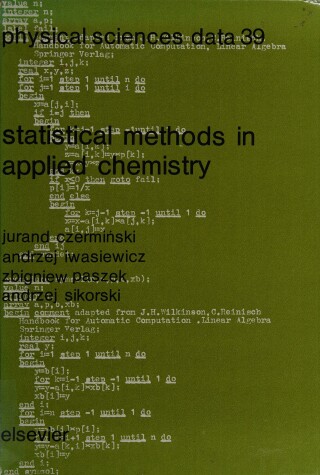Physical Sciences Data
4 total works
Handbook of Glass Data
by O. V. Mazurin, etc., M.V. Streltsina, and T.P. Shvaiko-Shvaikovskaya
Published July 1983
This is the fourth volume of a comprehensive reference work on the properties of one-component, binary and ternary oxide glass-forming melts and glasses. Part A ``Silica Glass and Binary Silicate Glasses'' was published in 1983, and Part B ``Single-Component and Binary Non-Silicate Oxide Glasses'' in 1985. Part C, published in 1987, covered Ternary Silicate Glasses. The present volume covers ternary non-silicate glasses. All ternary systems are united into large groups according to the valency of the elements forming the corresponding oxides. Within each of these groups the data are classified by properties. The sequence is as follows: glass formation, crystallization, density, thermal expansion and other thermal properties, optical properties, viscosity, elastic properties and internal friction, strength, surface tension, chemical durability, electrical properties, diffusion, permeation and solubility of gases, ion diffusion, volatilization and magnetic properties. Extensive references are included, as are author, subject and formula indexes.
This book is an essential aid for all those working in research laboratories of glass-making firms, university lecturers, and undergraduate/post-graduate students involved with materials science. Previous parts have already proved their usefulness to a great many people and have been described as follows: "The Handbook of Glass Data cannot be recommended too strongly. It must be held in every library where there is a serious interest in glass, and it should be on the shelf of every glass researcher." (Glass Technology).
This book is an essential aid for all those working in research laboratories of glass-making firms, university lecturers, and undergraduate/post-graduate students involved with materials science. Previous parts have already proved their usefulness to a great many people and have been described as follows: "The Handbook of Glass Data cannot be recommended too strongly. It must be held in every library where there is a serious interest in glass, and it should be on the shelf of every glass researcher." (Glass Technology).
Statistical Methods in Applied Chemistry
by Jurand Czerminski, etc., A. Iwasiewicz, Z. Paszek, and A. Sikorski
Published August 1990
Statistical Methods in Applied Chemistry deals in detail with the methods of statistical description and inference which are applied to chemical experimentation. It introduces the reader to the problems of random variables and their distributions, reviews principal statistical tests - both parametric and non-parametric, presents basic models of variance analysis, and deals with correlation of phenomena. The material is presented from the viewpoint of the experimenter. All methods are illustrated by numerical examples which reflect genuine experimental situations. Useful for students and teachers at universities and polytechnics, the book is of interest to scientists in all fields of pure and applied chemistry. Moreoever, it will be invaluable for researchers in all experimental sciences where statistical methods can be used.
Organic Colourants
by Makoto Okawara, etc., T. Kitao, T. Hirashima, and M. Matsuoka
Published December 1988
Dye chemistry, born in Europe at the end of the nineteenth century, is the root of modern organic chemistry which, in turn, together with inorganic and physical chemistry, has developed to produce today's polymer chemistry, biochemistry and materials science. With the establishment of the dye industry and dye technology, the definition of dyes was narrowed; their study became estranged from the field of the general chemist, and they were abandoned as subjects of basic research. Recently, however, dyes have been re-evaluated. In Japan the concept of the functional dye has been established in information, display, recording and storage, energy conversion, medicine and other fields. The extraction, expansion and utilization of the various functions of dyes have attracted much attention and a new field of colour chemicals has come into being. There are very few convenient data books useful for chemists who wish to participate and contribute to the advance of molecular design or functional applications of dyes - the best known work in the field is geared mainly to profesional dye chemists and it is becoming somewhat outdated.

